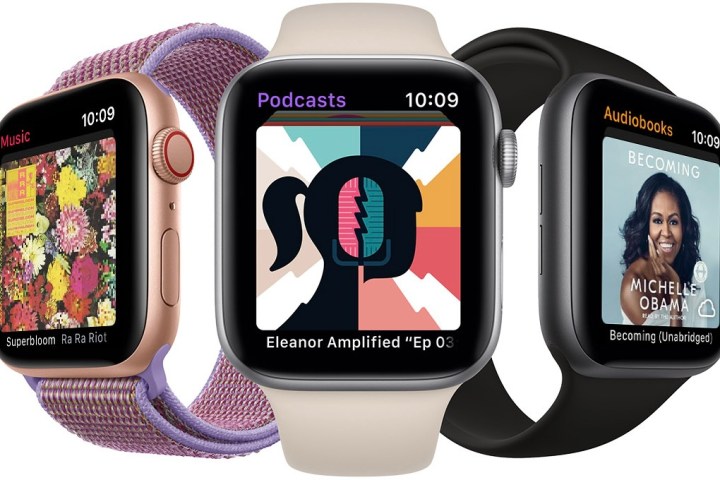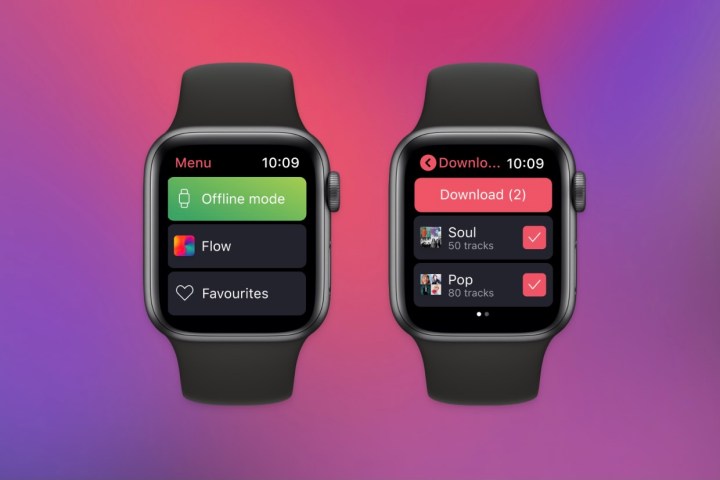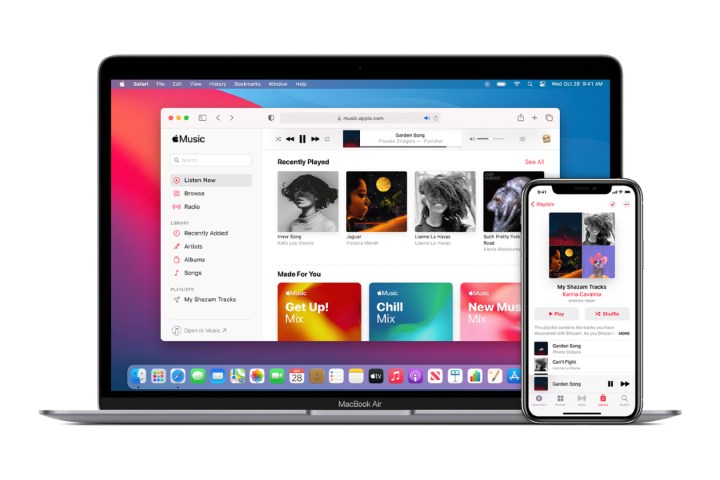The Apple Watch does it all: Personalized fitness regimens, intuitive sleep monitoring, extensive Siri capabilities, and an entire suite of iPhone skills (texting, calling, reminders, etc.) for when you want to ditch the phone. Speaking of which, one of the greatest Apple Watch features is the wearable’s ability to connect and stream, both online and offline (more on that below), to a number of today’s most popular music streaming services. To help you better understand exactly what music apps you can interface with your Apple Watch, and what each service can and cannot do, we’ve put together this guide to highlight the seven best ways to listen to music on your Apple Watch right now.
Keep in mind that certain features will only be compatible with particular hardware versions of the Apple Watch. The same goes for the operating system, as a number of music apps require watchOS 4.1 or higher for all in-app functions to work properly. Currently, the most up-to-date Apple Watch OS is watchOS 7.5, but with WWDC 2021 on the way, we can expect that to change and bring some new WatchOS features as well. We’ll update this post accordingly.
Apple Music

Hailed as one of the most popular music streaming services, Apple Music is a must-have music app for Apple Watch owners, with single-user plans starting at $9/month. Right off the bat, Apple Music has one of the cleanest and most responsive music streaming interfaces of this roundup. Control options include play/pause, track skipping, rewinding, and volume controls by way of the Apple Watch’s digital crown. For the Siri fans, Apple’s whip-smart voice assistant is onboard as well. Users can pull up songs, artists, and custom playlists by asking Siri to do so or by making selections manually on the watch face.
If you’re torn between LTE and non-LTE versions of the Apple Watch, there are a few benefits to going totally mobile. For one, you’ll be able to keep the iPhone at home while trail-running, as the LTE-powered Apple Watch can stream music without being paired to a mobile device. Additionally, Siri commands for non-LTE Apple Watches will be routed through your phone instead of directly through the wearable.
Apple Music also serves as one of the easiest ways to sync your existing iPhone music library with the Apple Watch. Pairing to an iPhone also allows for automatic syncing of Apple’s weekly playlists, including New Music, Chill Mix, Favorites Mix, and Heavy Rotation — a curation of your most-listened-to songs, albums, and artists.
Spotify

Going toe-to-toe with Apple Music, Spotify is another top music option for Apple Watch owners, thanks to the support offered for both the free and paid versions of the app. With a Premium subscription, Spotify users can play/pause, skip forward, and rewind, as well as see their most recently played songs, artists, and playlists. There’s also built-in Siri support. Users can ask the voice assistant to play their favorite tracks and artists, play/pause, skip, rewind, and more — although an Apple Watch Series 3 running watchOS 6 or higher is recommended for all Siri functions to work properly.
Additionally, Spotify offers Apple Watch owners the ability to go totally mobile. Premium subscribers with LTE-powered Apple Watches are now able to download playlists and podcasts to their watches for offline listening. Previously, even paid Spotify subscribers required an iPhone to be paired for any kind of music streaming. Keep in mind that offline listening is limited to only 96Kbps.
While a free Spotify account still nets you play/pause, track skipping, and output controls through Spotify Connect, the $9/month Premium tier unlocks expanded listening capabilities and the ability to leave your phone behind.
Pandora

Pandora has been around forever, which makes it a no-brainer music streaming addition for the Apple Watch. Those looking to take advantage of the app’s full suite of capabilities will want to make sure they’re using an Apple Watch Series 3 with watchOS 6 or higher, as well as a paid Pandora subscription and an iPhone running iOS 13 or higher. Like Spotify, Pandora does offer a free listening tier, but with several playback limitations, including ads.
A Pandora Premium subscription ($10/month) allows Apple Watch owners to listen to music offline (mobile device required), although there’s a cap to the content you can listen to. For Premium users, that’s the 10 most recent songs, artists, or playlists. Pandora Plus subscribers ($5/month) can only receive three of their most recent listens.
Controls include play/pause and a volume ring, along with the ability to swipe right to choose what offline content to listen to (as outlined above). Siri commands are also limited to your paired iPhone. While not as encompassing as Apple Music or Spotify, Pandora is still a decent music app for the Apple Watch.
Deezer

To experience the full slate of Deezer’s music streaming capabilities for the Apple Watch, you’ll want to be a paid subscriber. Premium memberships will run you $10/month and includes offline listening (paired iPhone required) and the ability to download tracks directly to your Apple Watch. Do note that you’ll need to own an Apple Watch Series 3 with an iOS device running iOS 6 or higher in order to use the Deezer app at all.
For paid subscribers, music listening is divided into four categories on the watch face: Flow (an automated Deezer playlist based on your listening habits), My Music (choose from your favorite songs, artists, albums, and podcasts), Favorite Tracks, and whatever track was most recently listened to. Controls include play/pause, track skipping, rewinding, shuffle, repeat, and the option to “favorite” individual tracks.
While services like Apple Music and Spotify are available as stand-alone apps for the Apple Watch, Deezer must be downloaded and launched through your paired mobile device.
Tidal

One of the premier destinations for high-quality digital streams, Tidal is an excellent Apple Watch service. With memberships starting at $9/month and totally untethered listening (no synced device required), Tidal users can take their favorite tracks, artists, and playlists almost anywhere. Similar to Spotify, offline listening is limited to 96Kbps, which isn’t very impressive, especially for a music service renowned for its lossless playback and hi-res streaming.
Tidal users can expect all the most crucial control options, including play/pause, track skipping, rewind, as well as access to tabs of albums, artists, and playlists directly from the watch face. Currently, the Tidal app offers no Siri support.
If you’re looking to run Tidal on your Apple Watch, make sure you own an Apple Watch Series 3 running watchOS 7.1 or higher.
iHeartRadio

Launched in 2020, the iHeart Radio Apple Watch app brings all your favorite tracks, albums, and radio stations together under one roof. Right on the watch face, users can search for music, listen to recently played songs, and control what’s playing with play/pause, track skipping, and more, all without the need of your iPhone.
iHeartRadio paid subscriptions (Plus for $5/month or All Access for $13/month) will net you the extra benefit of adding songs to your “favorite” playlist.
If you’re iHeartRadio or die, then make sure you’re the proud owner of an Apple Watch Series 3 running watchOS 6.2 or higher.
Your synced library

You can also use Apple Music to sync your existing iCloud music library to your Apple Watch. Once paired, your tunes will be stored in the Music app on the Apple Watch’s home screen. To sync your library, grab your iPhone, tap Settings, then Music, then toggle on the option for the iCloud Music Library.
In terms of hardware, you’ll need to own an Apple Watch Series 3 for this music-listening option to work.



